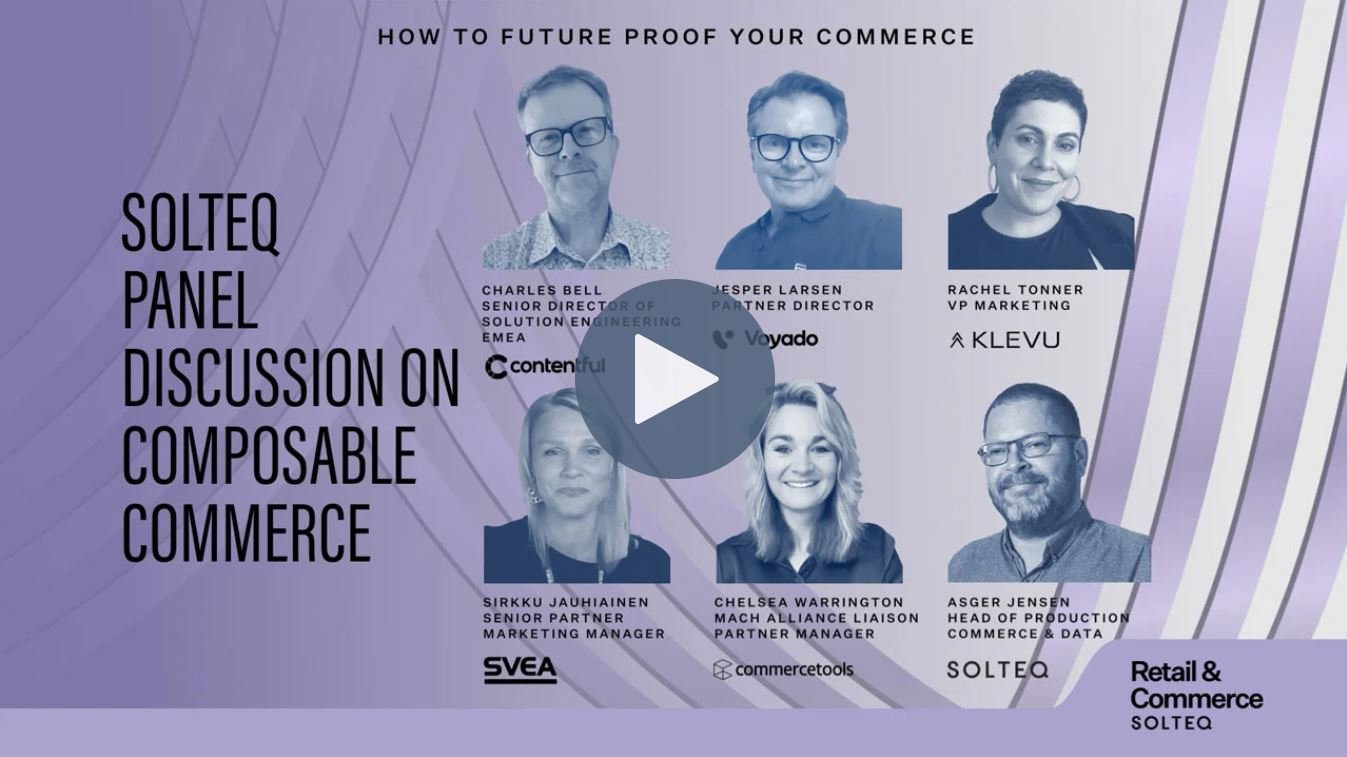Season 1 - Episode 1
🎙️ How to simplify personalization - without losing the human touch
Is your personalization strategy helping customers or creeping them out?
In the debut episode of Simplifiers, host Amel Gaily welcomes Solteq experts Pia Pekkala and Charlotte Wegeberg to explore why personalization so often fails and how to fix it.
Discussed in this episode:
Episode timestamps:
0:04 – 3:42 → Introduction by Amel: What is Simplifiers? and meet the Guests: Pia's and Charlotte’s backgrounds
3:43 – 5:13 → What is personalization?
5:14 – 6:45 → Knowing your customer without being intrusive
6:46 – 7:44 → The top 3 challenges companies face with personalization
7:45 – 9:52 → Charlotte’s Nordic perspective & data silos
9:53 – 10:23 → “It’s not a box”: Personalization as a mindset
10:24 – 12:38 → Why companies overcomplicate personalization
12:39 – 14:51 → Segmentation and enterprise complexity
14:52 – 17:33 → Data usage & trend-based personalization
17:34 – 19:15 → Transparency in data: shoe size example
19:16 – 21:05 → Respectful use of data and embedded transparency
21:06 – 24:22 → Return on investment: Metrics and business KPIs
24:23 – 26:20 → Long-term value and brand perception
26:21 – 27:12 → Testing, learning, and tactical KPIs
27:13 – 29:01 → Personalization maturity model
29:02 – 31:08 → Where are you now, where do you want to go?
31:09 – 34:03 → Segmentation examples and keep-it-simple philosophy
34:04 – 35:30 → Vision vs. execution: Netflix expectations vs. reality
35:31 – 37:17 → Real-life personalization success story: travel site
37:18 – 40:06 → When personalization goes too far & how to simplify
40:07 – 41:38 → Technology’s role and right-sizing your stack
41:39 – 44:24 → Emerging trends: AI as assistant, not a threat
44:25 – 45:57 → Practical takeaways: where to start
45:58 – End → Wrap-up and teaser for next episode
Episode transcript:
Introduction by Amel: What is Simplifiers? and meet the Guests: Pia and Charlotte’s backgrounds
[Amel]
Welcome to Simplifiers, the podcast that cuts through the noise and complexity of digital transformation to uncover how businesses can thrive by keeping things, well, simple. I’m your host, Amel Gaily. Today, we’re diving into a topic that’s often overhyped and under-delivered: personalization.
Whether you're a CMO trying to justify investment, or a business owner wondering if you even need personalization, this episode is for you. Joining me are two brilliant experts from Solteq who live and breathe this space.
First up: Pia Pekkala, Senior Advisor in Digital Content at Solteq. She’s spent her career at the crossroads of content, customer experience, and data.
[Pia]
I have a diverse background across business areas, always connected to enhancing digital customer experience—whether through support, marketing, or sales. My education is in communications, and I realized early on that I love tech and using technology. But I kept asking myself: why is it so hard for businesses to extract real value from it? That led me into the tech space.
[Amel]
Thank you! Next is Charlotte Wedeberg, Nordic Marketing Manager at Solteq. She brings a regional lens on how personalization plays out across markets.
[Charlotte]
Thanks, Amel. My journey into tech was a bit accidental. I started in retail, and someone suggested I try something in tech. I figured, why not? The internet seemed to be “the next thing.” That was the beginning. Over time, I realized how fascinating marketing in tech is, and I’ve stayed ever since. Now I work across the Nordics, which brings so many perspectives to digital communication.
[Amel]
Let’s tackle the elephant in the room: personalization. It’s been a buzzword for years, but many still struggle to get it right. So, what is personalization?
What is personalization?
[Pia]
It’s about tailoring the customer experience based on their interests or behavior. That can happen anywhere—digitally, physically, or at any touchpoint. It has to be relevant to the individual.
[Charlotte]
Exactly. But it’s also important not to go too far. You need to know your customers without being invasive.
[Pia]
Right. Knowing your customer’s shoe size doesn’t mean you should use it in marketing. There’s a thin line between “personalized” and “creepy.”
[Amel]
Such a concrete example. You want your customers to feel impressed—not spooked.
[Pia]
Exactly. You don’t want to end up being the creepy neighbor.
Top Challenges with Personalization
[Pia]
Three key barriers:
- Silos – Different teams don’t collaborate, making consistent experiences hard.
- Data Chaos – Too much data, not enough clarity on what’s useful.
- ROI Blindness – Many companies don’t measure personalization effectively. They use the wrong KPIs or expect short-term results from what is a long-term strategy.
[Charlotte]
Even in Nordic markets, the challenges are the same. The biggest issue? Siloed data. Everyone—sales, marketing, delivery—has valuable data, but it isn’t unified.
Personalization is Not a Product
[Pia]
Personalization isn’t a boxed service. It’s a mindset. You need to understand your customers and internal processes to deliver it effectively.
[Amel]
That’s key. It’s not about hitting a threshold—just starting with what you have.
[Pia]
Exactly. It’s about serving customers better. Start with one clear customer touchpoint where you can improve, then iterate.
[Charlotte]
We’re working on segmentation ourselves—by industry, by role. It’s complex, but incredibly valuable.
[Pia]
In large enterprises, it’s about understanding the full landscape of segments before jumping into tools. That’s the smarter starting point.
On Data & Transparency
[Charlotte]
Each year, we collect trend data by sector and role. We then match it with our services to plan campaigns and sales strategies. It’s long-term planning powered by insight.
[Pia]
And transparency is crucial. Customers expect us to use their data—but only when we explain how and why. If you’re transparent, people will accept personalization.
[Amel]
So true. Transparency shouldn’t be an add-on—it should be baked into the process.
ROI & Metrics
[Pia]
One of the biggest challenges is measuring ROI. Too often, companies treat personalization as a campaign or a product feature—like a recommendation engine or email. But personalization should ladder up to bigger business goals like customer lifetime value or improved NPS. And that takes time.
[Amel]
And word of mouth still matters. Great personalization leads to great experiences, which leads to brand advocacy.
[Charlotte]
Exactly. Metrics should align with strategy—and personalization needs to evolve constantly.
[Pia]
And test. You need a hypothesis. Try, measure, learn.
Simplifying Personalization
[Amel]
Let’s shift to solutions. Solteq has a Personalization Maturity Model—what is it?
[Pia]
It helps businesses assess where they are—from manual efforts to advanced automation. It also helps define where they want to go and what steps to take.
[Amel]
What are three practical steps for beginners?
[Pia]
- Identify your current maturity level.
- Define your “ideal state.”
- Start with low-effort, high-impact actions. Don’t try to fix everything at once.
[Charlotte]
Yes! And don’t overengineer. Don’t build a rocket when a Volkswagen will do.
[Pia]
Always, always start with the customer.
When It Works (And When It Doesn’t)
[Pia]
One success story: a travel brand personalized a landing page based on intent—skiing vs. beach holidays. A simple, single touchpoint boosted engagement massively.
[Amel]
That’s a perfect example.
[Pia]
But it can go wrong too. One brand tried to hyper-personalize everything—content, UI, images—by segment. They lost brand consistency. Eventually, they stripped it back to basics and rebuilt smarter.
[Amel]
Mistakes are part of the process. A/B test, iterate, learn.
Tech & AI’s Role
[Charlotte]
AI is a huge trend. But it should assist, not replace. It’s about using it wisely.
[Pia]
Exactly. AI is only as good as your data. Start by improving your data foundation.
Final Advice
[Charlotte]
Join our business labs. Assess your maturity. Start small. Don’t try to leap too far.
[Pia]
Yes. Start where you are. Understand your current state, define your ideal outcome, and build toward it.
[Amel]
That’s the heart of Simplifiers. Personalization doesn’t have to be complex. It just needs to be human.










